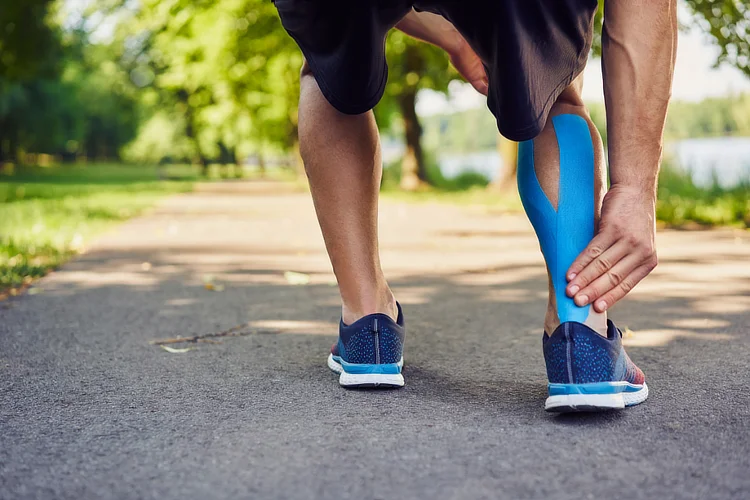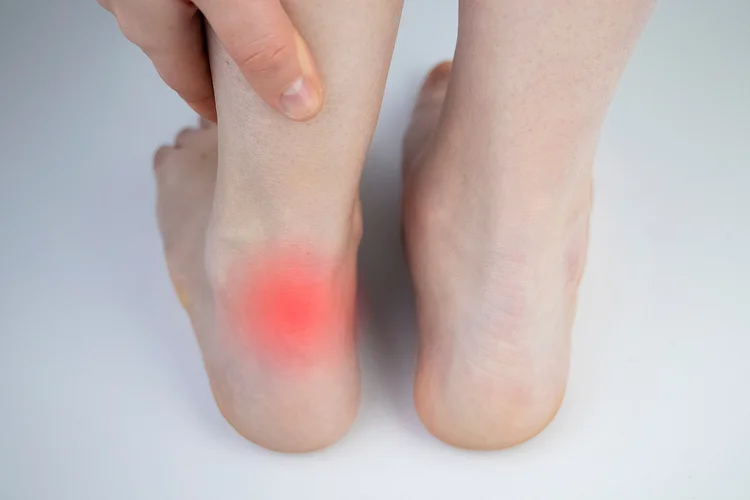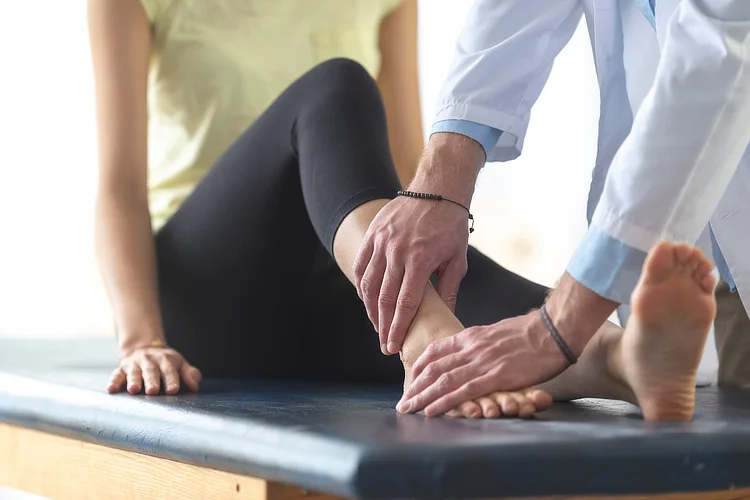Achilles Tendonitis: Causes, Symptoms, and Treatment Options
Information reviewed by: Dr. Foo Gen Lin | Last updated: Oct 29, 2025
Achilles tendonitis can worsen without early intervention, leading to prolonged pain or rupture. Dr Foo provides timely, tailored treatments to support recovery and long-term tendon health.
MBBS (University of London) | MMed (Ortho) | FRCSEd (Ortho) | FAMS (Ortho)


What Is Achilles Tendonitis?

Achilles tendonitis, also known as Achilles tendinitis, is an overuse injury that
causes inflammation in the Achilles tendon, the strong band of tissue that
connects the calf muscles to the heel bone.
While it is most common in athletes and
individuals with an active lifestyle, it can also affect those who suddenly increase their
level of physical activity without proper conditioning.
If left untreated, persistent tendon
irritation may progress to chronic Achilles tendinopathy, leading to long-term pain
and reduced mobility.
What Causes Achilles Tendonitis?
Achilles tendonitis develops when repetitive stress leads to small tears in the tendon, triggering pain and stiffness, particularly during movement. Common causes include:
- Overuse and Repetitive Stress – Repeated activities such as running, jumping, or sudden increases in exercise intensity place excessive load on the tendon.
- Weak Calf Muscles – Weakness in the gastrocnemius and soleus muscles can increase strain on the Achilles tendon.
- Improper Footwear – Worn-out shoes or those lacking proper arch support fail to distribute pressure evenly, increasing stress on the Achilles tendon.
- Poor Foot Alignment and Movement Patterns – Conditions such as flat feet, high arches, or an uneven walking pattern can put extra pressure on the Achilles tendon, causing it to work harder and increasing the risk of injury.
- Ageing and Degeneration – As the tendon weakens with age, its ability to recover from stress diminishes, making it more susceptible to inflammation and injury.
Achilles Tendon Injury Symptoms

The primary symptom of Achilles tendonitis is pain and stiffness along the Achilles
tendon,
particularly in the morning or after periods of inactivity.
Other symptoms may include:
- Increased pain during or after exercise, especially with running or jumping.
- Tenderness or swelling at the back of the ankle.
- Limited ankle flexibility and difficulty pushing off the foot.
- A burning sensation or discomfort when stretching the calf muscles.
- A thickened appearance of the tendon in chronic cases.
Long-term Complications of Achilles Tendonitis
If Achilles tendonitis is left untreated or repeatedly aggravated, it can progress to
chronic Achilles tendinopathy, a condition where the tendon undergoes long-term
degeneration, leading to
persistent pain and stiffness.
Potential complications may include:
- Reduced Mobility and Impaired Performance – Long-standing Achilles issues can limit walking, running, and other weight-bearing activities, affecting overall quality of life and athletic performance.
- Tendon Thickening and Nodules – Repeated stress and incomplete healing can cause the Achilles tendon to thicken and form small, hardened lumps known as nodules. These scar tissue buildups may reduce flexibility, restrict movement, and cause persistent discomfort.
- Increased Risk of Tendon Tears or Rupture – A weakened tendon is more prone to partial or complete tears, which may require surgical intervention.
How Is Achilles Tendonitis Diagnosed?
Diagnosing Achilles tendonitis involves reviewing your medical history, conducting a physical examination, and using imaging tests if necessary to assess tendon damage.

1. Medical and Activity History
A review of your symptoms, current and past physical activity levels, and past injuries to identify potential causes of tendon irritation and rule out other conditions.
2. Physical Examination
An assessment of the Achilles tendon for tenderness, swelling, and stiffness. Pressure and passive movements may be used to pinpoint pain and evaluate flexibility or structural issues.
3. Functional Tests
Movement-based tests, such as a single-leg heel raise or toe walking, may be performed to evaluate tendon strength and pain response during activity. These tests help determine the severity of the condition and its impact on mobility and daily function.
4. Imaging Tests
If symptoms persist or severe damage is suspected, imaging tests may be recommended:
- Ultrasound – Uses sound waves to create live images of the tendon, helping to detect inflammation, thickening, or small tears.
- Magnetic Resonance Imaging (MRI) – Provides high-resolution images of soft tissues, useful for identifying structural changes in chronic cases or ruling out more severe tendon injuries.
Achilles Tendinopathy Treatment
Treatment for Achilles tendinopathy focuses on reducing pain, improving tendon
function, and preventing further injury.
A combination of conservative treatments, rehabilitation exercises, and advanced medical
therapies can effectively manage the condition. Surgery is only considered in severe cases
that do not respond to non-surgical treatments.
| Treatment | Description & Purpose |
|---|---|
| Conservative (Non-Surgical) Treatments | |
| Rest and Activity Modification | Avoiding high-impact activities such as running and jumping helps reduce strain on the Achilles tendon. Low-impact exercises like swimming or cycling may be recommended by your doctor as alternatives. |
| Stretching and Strengthening Exercises | As part of physiotherapy, regular stretching of the calf muscles improves flexibility, while eccentric strengthening exercises help rebuild tendon resilience and reduce pain. |
| Footwear and Orthotic Support | Supportive shoes with proper arch support and cushioning help distribute pressure evenly. Custom orthotics (shoe inserts designed to improve foot alignment and reduce strain) may help relieve pressure on the Achilles tendon. |
| Cold Therapy and Pain Relief | Applying ice packs to the affected area for 15 to 20 minutes several times a day can help reduce inflammation. Non-steroidal anti-inflammatory drugs (NSAIDs) may provide temporary pain relief. |
| Medical and Advanced Therapies | |
| Shockwave Therapy | Non-invasive sound waves stimulate blood flow and promote tendon healing. This treatment is often used for chronic cases that do not respond to conservative measures and is recommended alongside eccentric exercises and stretching to support recovery. |
| Platelet-Rich Plasma (PRP) Therapy | A regenerative treatment that involves injecting concentrated platelets from the patient's blood into the tendon to promote healing and reduce inflammation. |
| Surgical Intervention | |
| Debridement and Tendon Repair | A surgical procedure that removes damaged or degenerated tendon tissue to promote healing and restore function. Depending on the severity, it may be performed as a minimally invasive (arthroscopic) or open surgery. |
| Gastrocnemius Recession | A surgical procedure that lengthens the calf muscle to reduce strain on the Achilles tendon. It is often recommended for individuals with persistent calf tightness that contributes to Achilles tendonitis and limits flexibility. |
How Can Achilles Tendonitis Be Prevented?
Preventing Achilles tendonitis involves keeping the tendon strong, flexible, and resilient while minimising repetitive stress and overuse. Common strategies include:
- Gradual progression of activity levels to prevent sudden overuse and tendon overload.
- Regular stretching and strengthening exercises to improve flexibility and enhance tendon support.
- Wearing appropriate footwear with proper cushioning and arch support to minimise strain.
- Alternating between high-impact and low-impact activities such as running and swimming or cycling to reduce repetitive strain on the Achilles tendon while maintaining overall fitness.
Every patient deserves a treatment plan tailored to their needs. We start with non-surgical approaches before considering more invasive interventions.
Where Can I Find an Ankle Specialist in Singapore?
Apex Novena
admin@apexsportsclinic.sg
101 Irrawaddy Rd, #18-12 Royal Square Medical Centre, Singapore 329565
Nearest MRT: NS20 Novena
Apex East Coast
admin@apexsportsclinic.sg
112 E Coast Rd, #03-03/04 i12 Katong, Singapore 428802
Nearest MRT: TE26 Marine Parade
Why Do Patients Choose Apex Sports Clinic?
Sports Doctor in Singapore: Personalised & Affordable Care
Progressive Treatment Philosophy
We prioritise personalised, non-invasive solutions, progressing to specialised treatments, including surgery, only when needed for more effective and targeted care.
Holistic Patient-Centred Care
From diagnosis to rehabilitation, we provide comprehensive and seamless care for a wide range of orthopaedic conditions.
Specialist in Sports Orthopaedics & Injury Management
We combine expert injury management with a proactive approach to maintaining your body's strength and function, so you can recover fully and perform at your peak.
Patient Journey
1 . Schedule Your Appointment

2 . Expert Diagnosis & Consultation

3 . Customised Treatment Plan

Schedule an Appointment

Our Insurance Partners






Frequently Asked Questions (FAQs)
Two common signs of Achilles tendonitis are pain at the back of the ankle and stiffness along the Achilles tendon, especially in the morning or after rest. These symptoms often worsen during or after physical activity and may be accompanied by tenderness, swelling, or limited ankle flexibility. If symptoms persist or interfere with daily movement, it is advisable to consult an ankle specialist for proper assessment and management.
Achilles tendinitis is a specific form of tendonitis that affects the Achilles tendon, whereas tendonitis is a general term for inflammation in any tendon. The terms are often used interchangeably, but Achilles tendinitis refers specifically to irritation and inflammation of the tendon connecting the calf muscles to the heel. Proper diagnosis by a doctor or ankle specialist can help distinguish between generalised tendon issues and targeted Achilles involvement.
Eccentric heel drops, seated calf stretches, and isometric calf holds are commonly recommended exercises for Achilles tendonitis and tendinopathy. These exercises help reduce pain, improve flexibility, and strengthen the tendon gradually. They are often included in physiotherapy programmes and should be performed consistently under professional guidance. Always follow the advice of your physiotherapist, doctor or specialist to ensure exercises are appropriate for your condition and stage of recovery.
Exercises that involve high-impact loading such as jumping, sprinting, or uphill running should be avoided during recovery from Achilles tendonitis. These activities place excessive strain on the inflamed tendon and may worsen symptoms or delay healing. It is advisable to consult a physiotherapist or ankle specialist for a tailored exercise plan that supports recovery while avoiding further tendon irritation.
There is no instant cure for Achilles tendonitis, but early management can speed up recovery. Rest, ice, stretching, eccentric strengthening (slow, controlled lowering of the heel to build tendon strength), and supportive footwear can help reduce symptoms. Shockwave therapy or other medical treatments may be considered if conservative measures do not improve the condition. If you are experiencing persistent pain or limited mobility, it is advisable to consult an ankle specialist or physiotherapist for a personalised treatment plan.
The Achilles tendon is known in Chinese as "跟腱" (gēn jiàn). It refers to the strong fibrous cord connecting the calf muscles, the gastrocnemius and soleus, to the heel bone. This tendon is essential for walking, running, and jumping as it transmits the force from the calf muscles to lift the heel off the ground. Injuries to the Achilles tendon are common among active individuals and require proper rest and rehabilitation for recovery.
Achilles tendon pain can be managed by resting the affected area, applying ice, performing gentle stretching, and wearing supportive footwear. Physiotherapy, including eccentric strengthening exercises, can help restore tendon flexibility and strength. In some cases, treatments like shockwave therapy or platelet-rich plasma (PRP) injections may be considered to promote healing. If you are experiencing persistent or worsening pain, it is advisable to consult an ankle specialist or physiotherapist for further evaluation.
Mild Achilles tendonitis can improve on its own with adequate rest, reduced activity, and gradual rehabilitation exercises. However, chronic or severe tendon injuries, such as partial tears or tendinopathy, often require medical treatment to promote healing and prevent long-term complications. Proper diagnosis and guided rehabilitation are important to restore function and prevent recurrence. It is advisable to consult a physiotherapist or ankle specialist for a tailored recovery plan.
Recovery time for Achilles tendonitis varies depending on severity. Mild inflammation may resolve within a few weeks with rest and physiotherapy, while chronic or more severe cases can take several months to heal fully. Consistent stretching, strengthening, and gradual return to activity are crucial to avoid re-injury. If symptoms persist, it is advisable to consult an ankle specialist for further assessment and treatment.
Taping the Achilles tendon can help reduce strain and provide temporary support during activity. Kinesiology tape is typically applied along the calf and down to the heel to assist tendon movement and relieve tension. The technique and tension must be applied correctly to avoid restricting blood flow or altering gait mechanics. It is advisable to consult a physiotherapist or ankle specialist for proper taping guidance suited to your condition and activity level.
Achilles tendinopathy can cause mild discomfort to sharp, persistent pain at the back of the heel, especially during or after activity. Pain often worsens with running, climbing stairs, or standing on tiptoes and may be accompanied by stiffness and swelling. The intensity of pain depends on the extent of tendon inflammation or degeneration. If pain interferes with movement or daily activities, it is advisable to consult a physiotherapist or ankle specialist for appropriate management.
Achilles tendonitis can usually be resolved with proper treatment and activity modification. Most cases improve through rest, physiotherapy, and gradual strengthening, although recovery may take several weeks or months. Chronic or untreated cases can progress to Achilles tendinopathy, which requires longer rehabilitation. While symptoms can often be fully managed, recurrence is possible if contributing factors like overuse or poor footwear are not addressed. It is advisable to consult a physiotherapist or ankle specialist for appropriate care.
Achilles bursitis involves inflammation of the fluid-filled sac (bursa) located between the tendon and heel bone, while Achilles tendonitis refers to inflammation of the tendon itself. Both can cause pain near the back of the heel, but bursitis pain typically occurs closer to the heel bone and may worsen when wearing shoes. Proper diagnosis through clinical assessment or imaging helps determine the source of pain and guide appropriate treatment.
Pain in the Achilles tendon when wearing shoes often occurs due to pressure from rigid heel counters or poor shoe fit that irritates the tendon. In cases of Achilles tendonitis or bursitis, inflammation makes the area more sensitive to friction. Supportive footwear with adequate cushioning, soft heel padding, and proper fit can help reduce irritation. If discomfort persists, it is advisable to consult an orthopaedic or foot specialist for assessment.
Massage may help relieve tightness and improve blood flow around the Achilles tendon, supporting recovery in mild or chronic cases. However, direct or deep pressure on an inflamed tendon can worsen pain and irritation. Gentle soft-tissue techniques are generally safer once acute inflammation has settled. Always follow the advice of your physiotherapist before incorporating massage into your treatment plan to ensure it complements other rehabilitation exercises.
Walking with Achilles tendonitis is generally acceptable if the pain is mild and not worsening, but excessive walking or high-impact activity may delay healing. Rest and activity modification are important to reduce tendon strain. Supportive footwear and gentle stretching can help maintain mobility without aggravating symptoms. If walking causes persistent pain or stiffness, it is advisable to rest and consult a doctor or specialist for tailored guidance.
Several conditions can mimic Achilles tendonitis, including Achilles bursitis, retrocalcaneal bursitis, partial tendon tears, and insertional tendinopathy. Less commonly, nerve entrapment or referred pain from the calf or ankle joint can cause similar symptoms. Imaging tests such as ultrasound or MRI are often used to confirm diagnosis and rule out other causes. If you experience persistent heel or ankle pain, it is advisable to seek evaluation from an ankle specialist.
Gentle stretching can help maintain flexibility during recovery from Achilles tendonitis, but overstretching a sore or inflamed tendon may worsen symptoms. Stretching should only be performed once acute pain has improved and under guidance from a physiotherapist. Controlled, gradual stretches targeting the calf muscles can reduce stiffness and improve tendon mobility. Always follow the advice of your physiotherapist or ankle specialist to avoid aggravating the injury.

